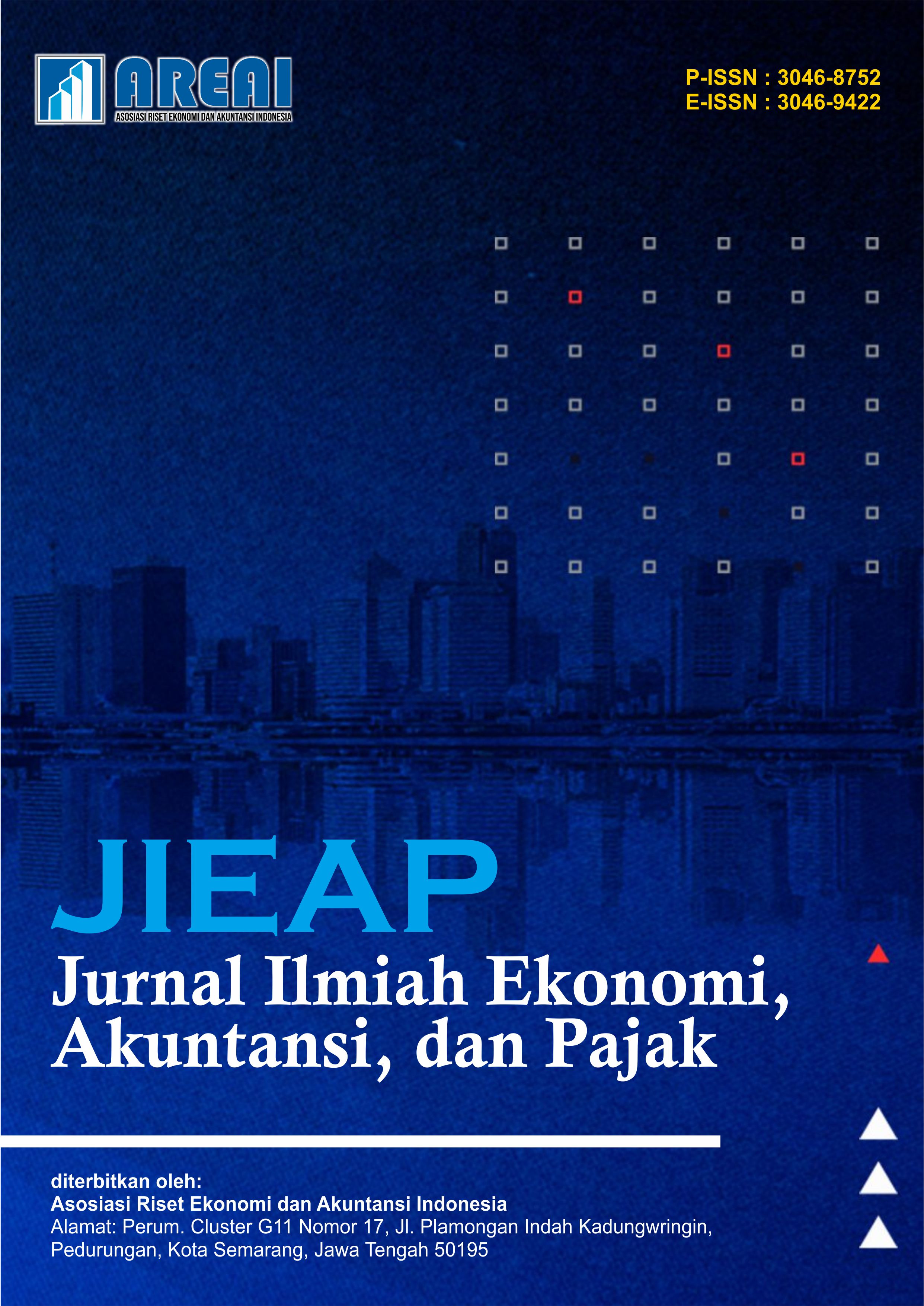Pengaruh Perputaran Kas, Perputaran Piutang dan Perputaran Persediaan terhadap Profitabilitas
Studi Kasus pada Perusahaan Sub Sektor Otomotif yang Terdaftar di Bursa Efek Indonesia Periode 2020-2023
DOI:
https://doi.org/10.61132/jieap.v2i3.1440Keywords:
Automotive Sector, Cash Turnover, Inventory Turnover, Profitability, Receivables TurnoverAbstract
This study aims to evaluate the effectiveness of current asset management, specifically cash, receivables, and inventory, and its impact on a company's ability to generate profits. The study focused on companies in the automotive sector listed on the Indonesia Stock Exchange (IDX) from 2020 to 2023. The research approach used a quantitative method with secondary data sourced from annual financial reports. The study sample included 11 companies, resulting in a total of 44 observational data sets over four years. Data analysis was performed using SPSS version 25 software to examine the relationships and influences between the study variables. The test results showed that cash management did not significantly influence profitability. This indicates that the amount of available cash does not always correlate with profit, possibly because cash funds are not optimally utilized in productive activities. Conversely, receivables management showed a negative correlation with profitability. This finding suggests that high receivables can burden cash flow and reduce a company's ability to generate profits. Meanwhile, inventory management has a positive and significant impact on profitability, indicating that good inventory control can support smooth production and sales, thereby increasing profits. Together, these three variables explained 68.4% of the variation in company profitability, while the remaining 31.6% was influenced by factors outside the model, such as operational efficiency, cost structure, and marketing strategy. These findings provide insights for automotive company management to prioritize inventory management and review cash and receivables policies to optimize financial performance.
Downloads
References
Armereio, C., & Saputra, A. A. (2020). Pengaruh perputaran kas, perputaran piutang dan perputaran persediaan terhadap profitabilitas perusahaan dagang yang terdaftar di Bursa Efek Indonesia periode 2015–2018. Jurnal Akuntanika, 6(1), 24–37.
Bisnis Indonesia. (2025). Berita terbaru bisnis, ekonomi, investasi Indonesia. https://www.bisnis.com/
CLA-Indonesia. (2025, Juli 5). Indonesia investment & buyer trade, industrial consulting service. Indonesia Investment. https://www.indonesia-investment.com/
Eksandy, A. (2018). Pengaruh perputaran modal kerja, perputaran piutang dan perputaran kas terhadap profitabilitas perusahaan (Studi pada perusahaan konstruksi sektor infrastruktur di Bursa Efek Indonesia periode 2012–2015). Dinamika UMT, 2(2), 1–14.
Harjito, A., & Martono, S. U. (2014). Manajemen keuangan. Ekonosia Fakultas Ekonomi Universitas Islam Indonesia. https://scholar.google.com/scholar?cluster=12368558613417938851&hl=en&oi=scholarr
Hery. (2016). Financial ratio for business: Analisis keuangan untuk menilai kondisi finansial dan kinerja perusahaan. Grasindo. https://perpustakaan.jakarta.go.id/book/detail?cn=INLIS000000000781412
Islamiah, N. I., & Yudiantoro, D. (2022). Pengaruh perputaran kas, perputaran persediaan, dan perputaran piutang terhadap profitabilitas perusahaan manufaktur yang terdaftar di BEI tahun 2019–2021. Al-Mal: Jurnal Akuntansi dan Keuangan Islam, 3(2), 177–197. https://doi.org/10.24042/al-mal.v3i2.12146
Jensen, M. C., & Meckling, W. H. (1976). Theory of the firm: Managerial behavior, agency costs and ownership structure. Journal of Financial Economics, 3(4), 305–360. https://doi.org/10.1016/0304-405X(76)90026-X
Kadir, V., Dungga, M. F., & Hamin, D. I. (2023). Pengaruh perputaran piutang dan perputaran kas terhadap profitabilitas pada perusahaan sektor industri barang konsumsi yang terdaftar di Bursa Efek Indonesia periode 2016–2020. Jambura: Jurnal Ilmiah Manajemen dan Bisnis, 5(3), Article 3. https://doi.org/10.37479/jimb.v5i3.17989
Kasmir, D. (2019). Analisis laporan keuangan. PT RajaGrafindo Persada.
Kriyantono, R. (2020). Teknik praktis riset komunikasi kuantitatif dan kualitatif. Prenadamedia Group. https://scholar.google.com/scholar?cluster=2801145847468468832&hl=en&oi=scholarr
Mulyatini, N., & Herlina, E. (2019). Pengaruh rasio likuiditas dan profitabilitas terhadap nilai perusahaan. Business Management and Entrepreneurship Journal, 1(2). https://doi.org/10.24912/jpa.v2i3.9568
Ramadhan, S. A., Buchdadi, A. D., & Siregar, M. E. S. (2024). Pengaruh profitabilitas, likuiditas, dan solvabilitas terhadap nilai perusahaan pada sektor industri barang konsumsi yang terdaftar di Bursa Efek Indonesia pada tahun 2017–2022. Jurnal Jurusan Pendidikan Ekonomi, 9(3). https://doi.org/10.23887/jjpe.v9i1.19982
Riyanto, B. (1989). Dasar-dasar pembelanjaan perusahaan. Yayasan Badan Penerbit Gajah Mada. https://www.goodreads.com/book/show/6233377-dasar-dasar-pembelanjaan-perusahaan
Silalahi, O. E., Siregar, L., Tarigan, P., & Manurung, S. (2018). Pengaruh perputaran piutang dan perputaran persediaan terhadap profitabilitas pada perusahaan sub sektor makanan dan minuman yang terdaftar di Bursa Efek Indonesia. Sultanist: Jurnal Manajemen dan Keuangan, 6(1), 83–89. https://doi.org/10.37403/sultanist.v6i1.118
Sugiyono. (2017). Metode penelitian kuantitatif, kualitatif, dan R&D. Alfabeta.
Usuli, S. (2020). Analisis rasio likuiditas guna mempertahankan profitabilitas koperasi. Jurnal Ekomen, 20(1).
Wardana, W., Jubi, J., Inrawan, A., & Silaen, M. F. (2019). Pengaruh perputaran kas, perputaran piutang dan perputaran persediaan terhadap profitabilitas pada perusahaan sub sektor otomotif dan komponen yang terdaftar di Bursa Efek Indonesia. Financial: Jurnal Akuntansi, 5(1), Article 1. https://doi.org/10.37403/financial.v5i1.94
Downloads
Published
How to Cite
Issue
Section
License
Copyright (c) 2025 Jurnal Ilmiah Ekonomi, Akuntansi, dan Pajak

This work is licensed under a Creative Commons Attribution-ShareAlike 4.0 International License.





